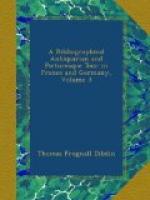Straubing, where we dined—and which is within two posts of Ratisbon—is a very considerable town. The Danube washes parts of its suburbs. As the day was uncommonly serene and mild, even to occasional sultriness, and as we were in excellent time for reaching Ratisbon that evening, we devoted an hour or two to rambling in this town. Mr. Lewis made sketches, and I strolled into churches, and made enquiries after booksellers shops, and possessors of old books: but with very little success. A fine hard road, as level as a bowling green, carries you within an hour to Pfaetter—the post town between Straubing and Ratisbon—and almost twice that distance brings you to the latter place.
It was dark when we entered Ratisbon, and having been recommended to the hotel of the Agneau Blanc we drove thither, and alighted ... close to the very banks of the Danube—and heard the roar of its rapid stream, turning several mills, close as it were to our very ears. The master of the hotel, whose name is Cramer, and who talked French very readily, received us with peculiar courtesy; and, on demanding the best situated room in the house, we were conducted on the second floor, to the chamber which had been occupied, only two or three days before, by the Emperor of Austria himself, on his way to Aix-la-Chapelle. The next morning was a morning of wonder to us. Our sitting-room, which was a very lantern, from the number of windows, gave us a view of the rushing stream of the Danube, of a portion of the bridge over it, of some beautifully undulating and vine-covered hills, in the distance, on the opposite side—and, lower down the stream, of the town-walls and water-mills, of which latter we had heard the stunning sounds on our arrival.[157] The whole had a singularly novel and pleasing appearance.
But if the sitting room was thus productive of gratification, the very first walk I took in the streets was productive of still greater. On leaving the inn, and turning to the left, up a narrow street, I came in view of a house ... upon the walls of which were painted, full three hundred years ago, the figures of Goliath and David. The former could be scarcely less than twenty feet high: the latter, who was probably about one-third of that height, was represented as if about to cast the stone from the sling. The costume of Goliath marked the period when he was thus represented;[158] and I must say, considering the time that has elapsed since that representation, that he is yet a fine, vigorous, and fresh-looking fellow. I continued onwards, now to the right, and afterwards to the left, without knowing a single step of the route. An old, but short square gothic tower—upon one of the four sides of which was a curious old clock, supported by human figures—immediately caught my attention. The Town Hall was large and imposing; but the Cathedral, surrounded by booths—it being fair-time—was, of course, the great object of my attention. In short, I saw enough within an hour to convince me, that I was visiting a large, curious, and well-peopled town; replete with antiquities, and including several of the time of the Romans, to whom it was necessarily a very important station. Ratisbon is said to contain a population of about 20,000 souls.




